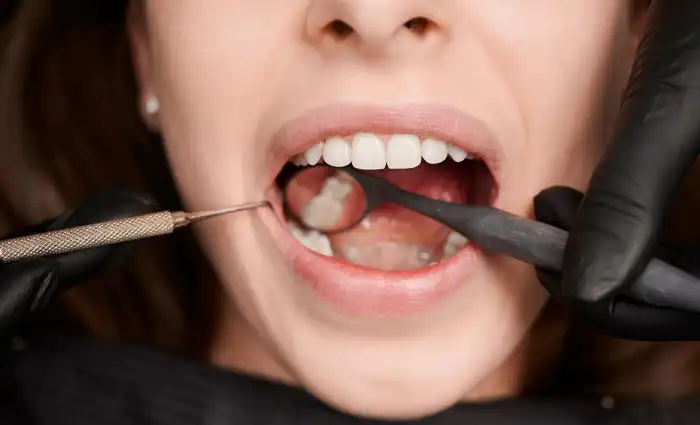Scaling and Polishing
Scaling is a common dental procedure that is used to remove hardened plaque, known as calculus, which, if not taken care of, can harm teeth and gums. After the scaling process, the teeth are polished to achieve a smooth surface texture.

What is Scaling and Polishing?
Scaling and polishing treatments are performed to thoroughly clean your teeth. Plaque and tartar gather around the teeth, eventually requiring special instruments for their removal because brushing alone cannot remove them. An ultrasonic device is employed to get rid of stubborn deposits from the teeth. This process is easy, quick, and painless, leaving your teeth feeling refreshed and healthy.
Plaque is the primary reason why a scale and polish procedure is necessary. After you have finished brushing your teeth, proteins that are present in your saliva will coat your teeth, providing a surface for bacteria to cling to the teeth and gums. As a result of bacterial attachment, you may develop cavities and gum disease. This not only poses a threat to your dental health but can also be a major cause of bad breath.
Suitable candidates for scaling and polishing include:
Individuals
with plaque buildup.
Patients
with gum disease.
Individuals seeking to
maintain optimal oral health.
The Scaling and Polishing Procedure
When you go for your routine dental appointment, the dentist will start by evaluating the condition of your mouth and then move on to scaling and polishing your teeth. During scaling, an ultrasonic cleaning tool is used to remove plaque and tartar between teeth and along the gum line. Bacteria that cause decay and gum disease can proliferate in plaque and tartar if left unchecked.
In some situations, a more thorough cleaning using hand instruments may be required to remove tartar that has accumulated on the root surfaces of teeth. This process, known as root planing effectively removes the bacteria residing in the gum pockets, promoting the healing of the gums. A suitable local anesthetic will be delivered before starting any treatment to ensure maximum comfort.
The next step after the scaling process is the smoothing of the teeth. This will get rid of any external or internal stains and make the surface of the teeth feel smoother. Dental professionals will improve the aesthetic appearance of a rougher tooth by using either a rotating brush with cleaning paste or an air-powder spray, particularly for tougher stains. The end result of this process is a set of teeth that are clean, smooth, and glossy.
With time, bacteria can multiply and harden into tartar; hence, one may have difficulty getting rid of it through brushing alone. This accumulation leads to cavities, bleeding gums, periodontal disease, and expensive dental treatment if neglected. The frequency for undergoing scaling and polishing sessions depends on individual oral health status and overall lifestyle factors. Normally, six-month visits are advised unless otherwise specified by the dentist.
Benefits of Scaling and Polishing
Regular scaling and polishing treatments are essential for maintaining optimal oral health. They get rid of plaque and tartar accumulations on your teeth; hence, you will have a clean and fresh feeling in your mouth. Along with promoting oral hygiene, getting a scale and polish can also help to eradicate or greatly reduce bad breath by getting rid of the bacteria responsible for causing the odor.
Care and Maintenance Post-Procedure
In order to soothe the area, rinse your mouth with lukewarm salt water 3 to 4 times daily. It is recommended to avoid hard foods for a couple of days and avoid smoking, as tobacco can delay the healing process of tissues.
Common Problems
Some possible issues that may result from tooth scaling and polishing are:




